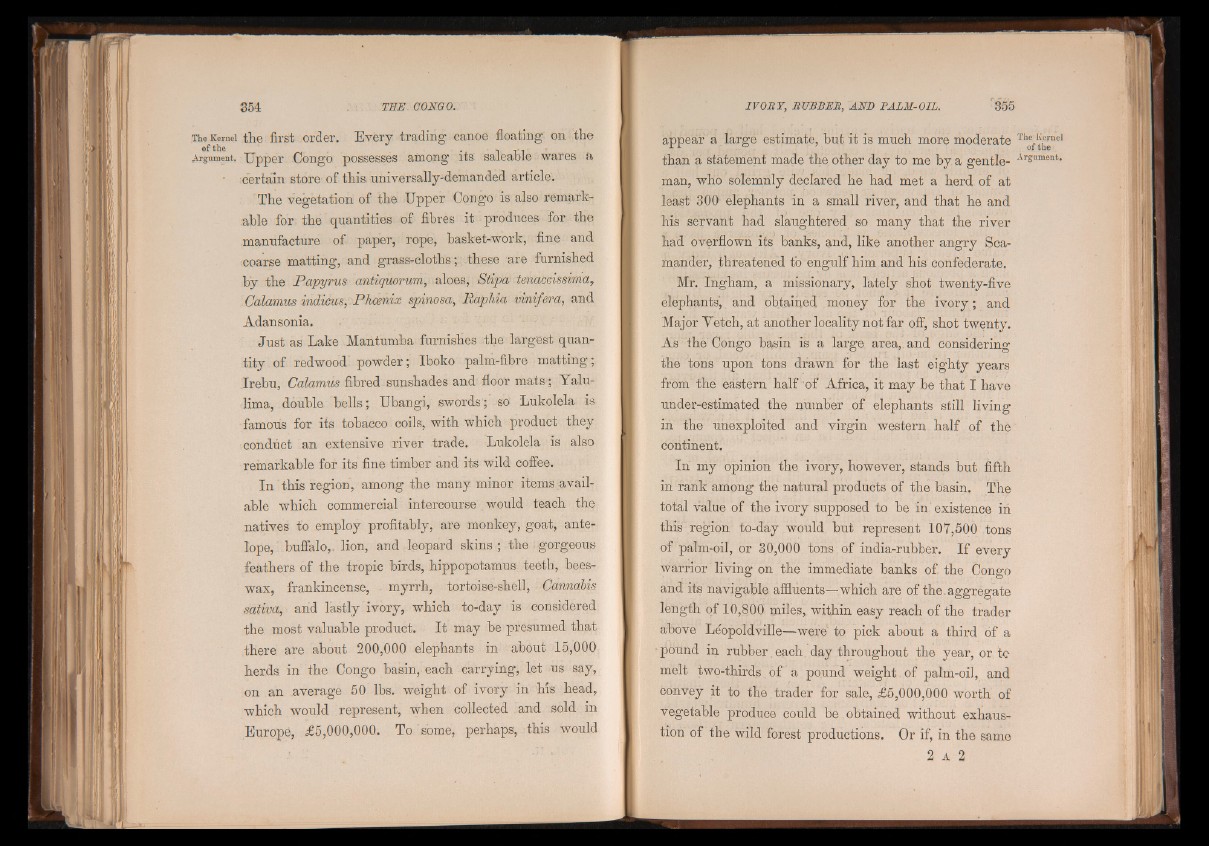
The Kernel the first order. Every trading canoe floating on the
of the . i i ' i Argument, Upper Congo possesses among its saleable wares a
certain store of this universally-demanded article.
The vegetation of the Upper Congo is also remarkable
for the quantities of fibres it produces for the
manufacture of paper, rope, basket-work, fine and
coarse matting, and grass-cloths; these are furnished
by the Papyrus, antiquorum, aloes, Stipa tenaceissirna,
Calamus indicus, Phoenix spinosa, Raphia vinifera, and
Adansonia.
Just as Lake Mantumba furnishes the largest quantity
of redwood powder; Iboko palm-fibre matting;
Irebu, Calamus fibred sunshades and floor mats; Yalu-
lima, double bells; Ubangi, swords';" so Lukolela -is
famous for its tobacco coils, with which product they
conduct an extensive river trade. Lukolela is also
remarkable for its fine timber and its wild coffee.
In this region, among the many minor items available
which commercial intercourse would teach the
natives to employ profitably, are monkey, goat, antelope,
buffalo,, lion, and leopard skins ; the ¡ gorgeous
feathers of the tropic birds, hippopotamus teeth, beeswax,
frankincense, myrrh, tortoise-shell, Cannabis
sativa, and lastly ivory, which to-day is considered
the most valuable product. It may be presumed that
there are about 200,000 elephants in about 15,000
herds in the Congo basin, each carrying, let us say,
on an average 50 lbs. weight of ivory in his head,
which would represent, when collected and sold in
Europe, £5,000,000. To some, perhaps, this would
appear a large estimate, but it is much more moderate
than a statement made the other day to me by a gentleman,
who solemnly declared he had met a herd of at
least 300 elephants in a small river, and that he and
his servant had slaughtered so many that the river
had overflown its banks, and, like another angry Sca-
mander, threatened fio engulf him and his confederate.
Mr. Ingham, a missionary, lately shot twenty-five
elephants', and obtained money for the ivory ; and
Major Vetch, at another locality not far off, shot twenty.
As the Congo basin is a large area,, and considering
the tons upon tons drawn for the last eighty years
from the eastern half ’of Africa, it may be that I have
under-estimated the number of elephants still living
in the unexploited and virgin western half of the
continent.
In my opinion the ivory, however, stands but fifth
in rank among the natural products of the basin. The
total value of the ivory supposed to be in ' existence in
this region to-day would but represent 107,500 tons
of palm-oil, or 30,000 tons of india-rubber. If every
warrior living on the immediate banks of the Congo
and its navigable affluents—which are of the.aggregate
length of 10,800 miles, within easy reach of the trader
above Leopoldville—were to pick about a third óf a
pound in rubber, each day throughout the year, or to
melt two-thirds of a pound weight of palm-oil, and
convey it to the trader for sale, £5,000,000 worth of
vegetable produce could be.obtained without exhaustion
of tbe wild forest productions. Or if, in the same
2 a 2
The Kernel
of the
Argument.